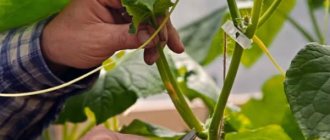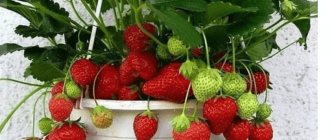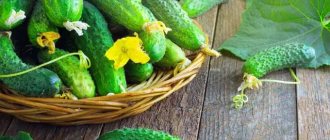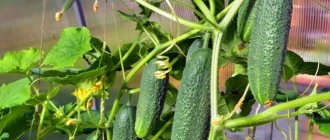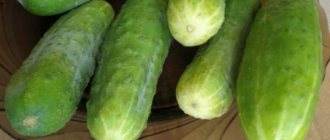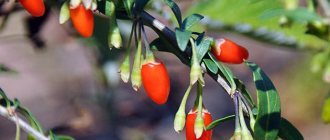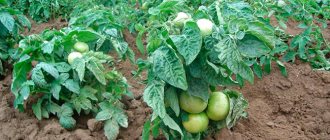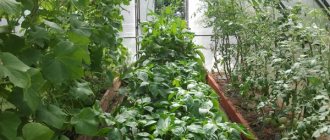Hermaphroditism, self-fertilization, self-pollination and parthenocarpy
Hermaphroditism is a general biological concept that is characteristic of many organisms.
Most higher plants are hermaphrodites. In this case, in terms of reproduction we are talking about either:
- about self-fertilization (a special case is self-pollination), when in the process of sexual reproduction they themselves produce both male and female gametes, the fusion of which forms a zygote. Usually this measure is forced for a plant, formed when there are no conditions for normal cross-pollination.
- about sequential hermaphroditism - during the formation of flowers, the anthers and stigmas do not ripen at the same time and then, on the one hand, self-pollination is prevented and, on the other hand, due to the non-simultaneous flowering time of various plants in the population, cross-pollination is ensured.
In any of the above cases, seeds are formed in the ripening fruits!
In plants, natural hermaphroditism is called monoecy (in one “house,” i.e., within one individual, both female pistillate and male staminate flowers develop) - cucumber is one of these plants. It is a bee-pollinated crop - this means that in order to set full-fledged fruits, it needs pollinating insects that transfer pollen from the stamens to the pistils.
In parthenocarpics, the so-called “virgin fertilization” occurs without pollination, usually with the formation of fruits without seeds or containing “empty” seeds without embryos. Plants characterized by the development of only seedless fruits are sterile and reproduce exclusively by vegetative means.
Parthenocarpy is known in many cultivated plants and is often a firmly established varietal characteristic. And cucumbers also have such specially bred hybrids.
To summarize, self-pollinating cucumbers do not exist as such; think about the integrity of the manufacturer or seller if you see a similar inscription on the bag. Cucumbers can be either bee-pollinated or parthenocarpic.
Bee-pollinated cucumbers: advantages and disadvantages of the crop
Insect-pollinated cucumbers are nothing new. Such plants have been grown in our temperate continental climate for many years. Recently, new varieties have been developed that make it possible to harvest vegetables at the earliest possible date. Typically, early ripening cucumbers begin to bear fruit after 40-45 days. The fruits have a delicate peel, white thorns, juicy pulp, size - 10-12 centimeters.
Many early cucumbers are salad cucumbers; their length differs from ordinary ones - they are slightly oblong (about 27 centimeters).
True, some early varieties have thicker skin, dark thorns, they can be eaten fresh and used for pickling.
Medium or late varieties of cucumbers come in different lengths. Tiny gherkins grow up to 5-9 centimeters. Hybrid varieties are distinguished by a bunched ovary, the length of the fruit is 9-12 centimeters. Such crops give a large harvest. However, cucumbers with similar qualities cannot be grown from the seeds of their fruits. Vegetables ripen only after 50-60 days. Basically, all late crops are grown for preservation or pickling.
Pros of insect-pollinated varieties:
- excellent taste characteristics;
- disease resistance;
- cold resistance;
- good yield under favorable weather conditions;
- seed can be obtained.
- dependence on the presence of insects;
- in the sun, with little watering, cucumbers become bitter;
- Yields may be reduced due to unfavorable weather conditions.
It is recommended to plant early, mid and late varieties in the garden. In this case, it will be possible to harvest throughout the season. Gardeners need to know that there are two types of cucumbers. Some grow on low bushes that you don’t have to deal with. Others form tall stems that need constant care. First, remove the side stepsons, form a stem, and at the end, pinch the top.
Crops with long stems need support; they are usually allowed to climb along a trellis. Bee-pollinated cucumbers are usually planted in an open bed. Although it can be planted in a film greenhouse or greenhouse. It is advisable that the plant be completely open to insects at the time of flowering.
The best parthenocarpic cucumbers - photos, descriptions, growing features
Parthenocarpic cucumbers produce fruits of equal size and color without bitterness, which do not turn yellow (since they do not require ripening of the seeds), are stored for a long time and are not damaged during transportation. Such cucumbers are ideal for protected soil conditions - greenhouses, balconies and home windowsills, where pollinating insects cannot reach. And this is the main advantage of such hybrids.
If you want to grow cucumbers in open ground, then it is better to give preference to bee-pollinated varieties and hybrids. The fact is that on some parthenocarpic cucumbers, when pollinated by insects or during sudden temperature changes, fruits of a curved shape and bloated are often formed. And the seeds of parthenocarpics are usually more expensive than ordinary bee-pollinated cucumbers.
Features of growing parthenocarpic cucumbers
Since barren flowers do not form on parthenocarpics, plants are formed a little differently. So, the main stem is pinched only when it becomes higher than the trellis - as a rule, at a height of about two meters.
To ensure that the borage is well ventilated and does not take up all the space in the garden bed, the side canes are also pinched. The lower part of the bush is blinded, i.e. in the axils of the first five leaves, all shoots and flowers are removed. Then 6 side shoots no more than 25 cm long are left. The next few shoots are pinched after they reach 35-40 cm in length, and the topmost shoots are allowed to grow to 45-50 cm.
Otherwise, caring for parthenocarpics is no different from caring for “ordinary” bee-pollinated cucumbers.
For your attention - several hybrids of parthenocarpic cucumbers that have proven themselves well in the middle zone.
Rules for pollination in a greenhouse
To carry out the pollination process yourself in greenhouse conditions, it is worth remembering the following rules:
- It is better to carry out painstaking work on the 2nd day after the opening of the inflorescences;
- You must remember the acceptable level of humidity in the room is 75%. Lower or higher readings may harm the pollen being carried;
- In order for the male pollinator plant to contribute to the ovary, it is necessary to maintain suitable temperature conditions. The work is carried out at +20-25 degrees. If the indicators are too high, the pollen loses its reproductive properties. As the temperature decreases, slow formation of ovaries is observed;
- To obtain a productive harvest, you need to transfer pollen material from one bush to another (cucumbers must be of the same variety).
- The procedure is carried out every day for 2-3 weeks until strong ovaries are formed. If the required conditions (temperature, humidity, pollination method) are violated, all efforts may be in vain.
See also the subtleties of growing, description and characteristics of cucumbers of the Graceful variety
Zozulya F1
A productive, early-ripening, self-pollinating hybrid with partial parthenocarpy. Designed for growing in a greenhouse or indoors, but in regions with mild climates it is also suitable for open ground. But keep in mind: when planted early, Zozulya F1 bears fruit better when pollinated by bees.
Greens are cylindrical in shape, with small tubercles, dark green, with pale stripes on thin skin, with excellent taste.
Among the advantages of this hybrid, one can also note resistance to cucumber mosaic virus, ascochyta blight, basal rot and olive spot. However, cucumbers are susceptible to fusarium, true and downy mildew.
Herman F1
This ultra-early hybrid was bred in Holland. It is recommended for cultivation in open ground and film greenhouses. Herman F1 bears fruit from early June to mid-September. Zelentsy are tied in bunches of 6-7 pieces. They are dark green, small (therefore ideal for canning), very tasty and not bitter. In addition, this plant is resistant to peronosporosis and powdery mildew, cladosporiosis, and cucumber mosaic virus.
However, German F1 cucumbers do not tolerate transplantation well, so the seeds need to be sown in separate and fairly spacious containers in order to transplant the seedlings directly into the garden bed. Plants, especially young ones, are afraid of the cold, so they are planted in the ground at an air temperature of at least 18°C. Borage is often affected by rust, so in rainy spring and summer it is impossible to do without regular preventive spraying with Fundazol.
Planting and caring for plants in open ground
Cucumber seedlings are planted in the garden at the end of May. If the air has warmed up to 15-18 degrees Celsius, there is no danger of night frosts, and the soil temperature is 10 degrees, then young plants can be transferred as early as mid-May. The seedlings are first hardened, that is, gradually accustomed to the new environment. At the end of May or at the beginning of June, you can immediately sow the seeds in the garden. True, the crop will begin to bear fruit only in July. But the bushes will grow more viable.
Before planting cucumbers, the soil needs to be prepared: dug, fertilized, loosened. A bucket of rotted humus and 30 grams of nitrogen, potassium and phosphorus fertilizers are added per 1 square meter of plot. Cucumbers prefer non-acidic soil. It is advisable to add another 500 grams of wood ash or dolomite flour. Before planting, the holes can be disinfected with a pink solution of potassium permanganate.
When choosing a place for cucumbers, it is advisable to take into account some nuances: bushes in direct sunlight quickly wither. Vegetables can be planted in partial shade or near tall crops (sunflowers, green beans). You cannot plant cucumbers in a bed where tomatoes and potatoes used to grow. Predecessors can be onions, carrots, radishes.
Cucumbers planted in the garden are watered regularly. For irrigation, use settled, warm water. About 4 liters of water are poured under each bush at a time. True, you can’t pour water under the root. Water the plants every 2 days, more often in hot weather, and stop watering in cool, rainy weather. When the plants bloom and begin to form ovaries, the water consumption is doubled. At the time of fruiting, the bushes also need more moisture.
Arina F1
This parthenocarpic hybrid of the female flowering type is characterized by rapid growth (even with a lack of light), strong branching of shoots and cold resistance. Greens are cylindrical in shape, bright green, with a glossy surface, bumps and white spines. The main advantage of the fruit is its very sweet taste.
The hybrid is resistant to powdery mildew, olive spot, common cucumber mosaic virus, and tolerant to downy mildew. However, this cucumber has one drawback - low yield.
Emelya F1
This is one of the most resistant to cucumber diseases, a parthenocarpic hybrid with a predominantly female flowering type. Designed for growing in greenhouses and under film cover. The plant is vigorous, indeterminate, weakly branched. The fruits are elongated, oval-cylindrical in shape, even green in color. The skin is thin, tender and without bitterness.
Emelya F1 has excellent cold resistance, so it produces a good harvest even in bad weather. Overgrown fruits do not lose their taste and are great for salads.
The disadvantages of this hybrid include weak resistance to downy mildew and the possibility of hermaphroditic (spherical-shaped) fruits appearing on plants.
Regina-plus F1
This hybrid of the female flowering type is characterized by weak branching, which facilitates the formation of the plant. Regina-plus F1 is suitable both for open ground (when grown in regions with mild climates) and for greenhouses and tunnels.
Greens are oval-spindle-shaped, with sparse tubercles and white spines. The fruits have excellent taste. The hybrid is characterized by early ripening and uniform fruit formation, resistant to powdery mildew, olive spot, common cucumber mosaic virus, and tolerant to downy mildew.
Be careful! Emelya F1 is a parthenocarpic hybrid of agro selection, just like Zozulya F1 and April F1. The friendly F1 family was bred by breeders, Herman F1 - Monsanto Holland, etc. But under the same names, some third-party manufacturers produce cucumber seeds with completely different varietal characteristics.
Of course, we have not listed all the popular hybrids of parthenocarpic cucumbers. Gardeners deservedly love Podmoskovnye Evenings, Danila, Seasons, Maryina Roshcha, Expedition, Bon Appetit, Tachanka and others. Among their diversity, you can easily choose a hybrid that is suitable for your site based on ripening time, shade tolerance, plant height, type of fruiting, type of fruit and many other characteristics.
Why do cucumbers have only one empty flower?
F1 Arina
Natalya Levitskaya
F1 Acorn
There is a large group of shade-tolerant cucumber hybrids cultivated in heated greenhouses from January to July or until the end of October (F1 Marathon, F1 Relay, F1 Manul, F1 TSHA 442, F1 Ladoga, F1 Northern Lights, F1 Olympics, etc.).
Last year, cucumbers were planted in a box on the balcony. The tops were gorgeous, the flowering was constant. But not just one ovary after flowering.
- Try to pinch the top (it is better to do this above the 5-6th leaf, but if you have already missed it, then pinch it as is) - this will stimulate the growth of side shoots, and there are always more female flowers on them.
- Self-pollinating varieties for greenhouses.
orchideaua
Site news to your email! Enter your Email
Frederica
Powdery mildew of cucumbers
weak
understand the growth of lateral shoots from almost every node of the main stem; side shoots are long and require pinching in greenhouses. Many modern hybrids with good branching are characterized by a valuable trait - SELF-REGULATION OF BRANCHING, when a high crop load on the main stem does not allow side shoots to quickly form (F1 Maryina Roshcha, F1 Chistye Prudy, F1 Matryoshka, F1 Junior Lieutenant, F1 Buyan, F1 Burevestnik, F1 Boy with a finger, F1 Hit of the season, F1 Green Wave, F1 Dragonfly, etc.). Later, when most of the harvest has been harvested from the main stem, the side shoots will begin to grow faster. Thus, in the presence of self-regulation of branching, much less time is spent on pinching side shoots. This is especially important if your stay in the garden area is limited to weekends - such plants do not have time to overgrow too much during the working week.
F1 Lord
F1 Company secret
F1 Teremok
F1 Northern Lights
They pollinated with a brush and blew on the flower, all in vain.
Natka56
Use special preparations (“Ovary”, etc.)
ARTMAX
Parthenocarpic cucumber is a variety or hybrid that is capable of producing fruits WITHOUT pollination. ...Why are these parthenocarpic cucumbers needed in principle? In principle, it’s clear why - for...
Spaanch Boob
What cucumbers do gardeners most often look for when buying seeds? Probably, a friendly chorus will answer - self-pollinating! What kind of cucumbers are these? Let's try to figure out today what it is and why we need it?
How to protect cucumbers from late spring cold?
Yulia Muromskaya
branching includes early ripening sprinter hybrids that give away most of the harvest in the 1st month of fruiting: F1 Alphabet, F1 Cupid, F1 Regina-plus, F1 Bouquet, F1 Balalaika, etc. There are practically no side shoots - i.e. They are very short (up to 10-15 cm) “bouquet branches” - with close internodes, often without leaves, which stop growing on their own. Such bouquet branches with filling greens look like bunches of fruits.
F1 Junior Lieutenant
F1 First class
Some bunched gherkins are also shade-tolerant (F1 Maryina Roshcha, F1 Chistye Prudy, F1 Hit of the Season, F1 Green Wave).
But for high-quality pollination, they need to be sown with varieties that produce a large number of male flowers (barren flowers). Breeding companies put colored pollinator seeds in bags of the main bee-pollinated hybrids. These bags have a special symbol - a yellow seed in a pink square and the text “colored seeds are a pollinator.”
F1 Relay
Apparently this is some kind of special variety.
dolfanika
And also read the information about your variety - on some varieties, flowering begins with male flowers, and female flowers will appear later.

